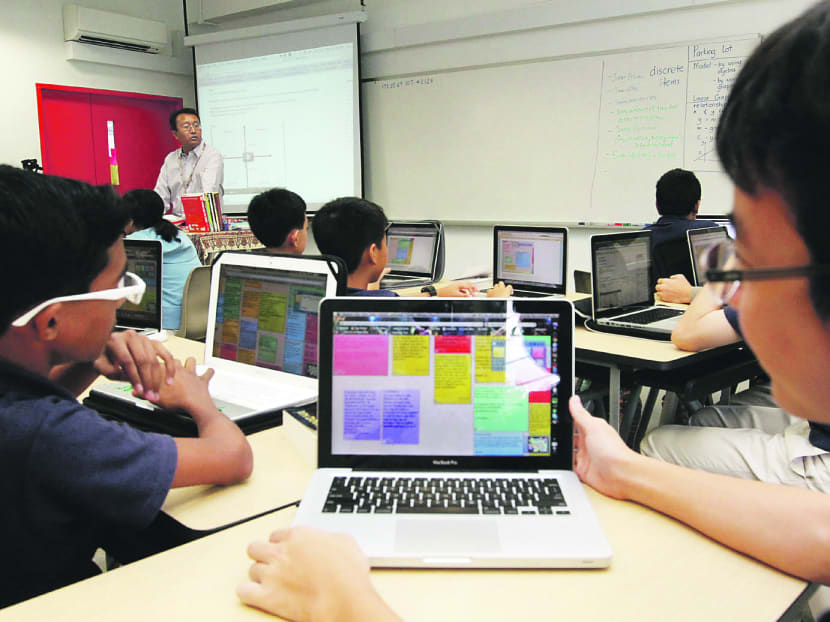How to use technology to engage students
Education in Singapore is recognised around the world for its use of information communication technology, together with a holistic curriculum that emphasises the quality of educators and their professional development.
Education in Singapore is recognised around the world for its use of information communication technology, together with a holistic curriculum that emphasises the quality of educators and their professional development.
Since 1997, the Ministry of Education has implemented nationwide masterplans to integrate the use of technology in education and equip students with the critical competencies needed for the workforce of tomorrow.
Campus-wide wireless Internet connectivity, online learning and the use of portable devices such as smartphones, tablets and laptops are now commonplace across our Singapore schools. The new generation is growing up surrounded by technology, and the use of touch-based devices is second nature to them.
Yet along with the benefits that technology can bring to enhance teaching and learning, there is now the worry that technology is hampering students’ attention spans and the ability to persevere in the face of challenges.
Perhaps we should take a closer look at how technology can be harnessed in seemingly natural environments to engage our youths in a way that they want to be engaged, and serve as a powerful enabler to help our young people to realise their full potential.
With information easily available at a click of a search button, the traditional role of educators as the primary source of information in learning environments will need to evolve. Educators will need to elevate their role in the classroom to become lead facilitators who can help students think beyond the surface of the information collected, differentiate credible sources from non-credible ones, and make sense of and extract value from the large volume of data.
By pointing students in the right direction to find credible information and providing value through immediate feedback, inspiration and encouragement, educators can play an even more crucial role than ever before to inspire the curiosity to learn, passion for knowledge, critical thinking and higher order learning in this digital age.
LEARNING WITH APPS
Technology-enabled pedagogies such as Flipped Classroom and Studio-Based Learning are examples that have worked well in modern education scenarios across the world.
Flipped Classroom reverses the sequence of events in traditional classrooms by enabling students to first conduct their research on the Internet, before coming to class to interact and share their information with educators and fellow classmates. In this way, students are engaged through the active exchange of ideas with their fellow classmates as well as real-time feedback from the educator.
Studio-Based Learning, on the other hand, takes a design-focused approach where students work in groups within a class to design a solution to a pre-phased problem. During the discussion process, students can critique and provide feedback to one other to improve their solution, harnessing collective wisdom to create new solutions to the problem. In such settings, cloud-based online collaboration tools enables easy content creation, real-time collaboration between teachers and students and live feedback from the educators.
More so than ever, technology has also made learning easily accessible across physical and geographical boundaries. Through the cloud, students can now access learning materials anytime, anywhere, enabling equal access to educational materials without fear of missing out in class. In addition, communication tools such as Skype has enabled cross country collaboration between classrooms, opening up a whole new world of possibilities for teaching and learning.
While there are limitless possibilities that technology can bring, it is important to note that the fundamental role of education is to empower people with the knowledge and skills to be ready for their future. We need to continuously challenge the boundaries of teaching and learning, and look at how we can better harness the power of technology to empower students to realise their full potential.
In recent months, computational thinking – or learning the way computers ‘think’ - has come into focus as an essential skillset for the next-generation workforce. In recognition of its significance in enabling our young people to understand and work productively with technology in the years to come, the Infocomm Development Authority of Singapore (IDA) kick-started the Code@SG movement last year to develop computational thinking as Singapore’s national capability.
In support of the movement, Microsoft launched the Code for Change initiative in partnership with IDA, with the aim of developing computational thinking skills among 500,000 youths in Singapore over the next three years. With the collective goal of introducing coding and computational thinking to more students in schools in a fun and easy-to-learn manner, initiatives are now being driven on a nationwide scale to teach coding and computational thinking to students at an early age.
We cannot ignore the fact that technology is only going to be playing a bigger role in our future. Hence we need to work collectively across all levels, to help our young people be comfortable with technology, to build the talent foundation for our future.
ABOUT THE AUTHOR:
Stephanie Hung is senior director (public sector group) at Microsoft Singapore. She will be among the panellists on Channel NewsAsia’s Perspectives programme on ‘Schools in the Cloud?’ which airs at 8 pm on Wednesday.







